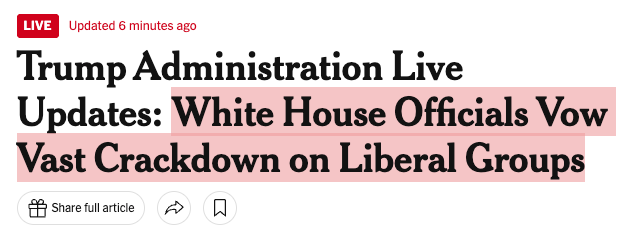The existential elephant this year end
Nonprofits and news organizations are going to be facing more and more threats to their ability to operate. Can year-end communications, including fundraising campaigns, do more to inform and organize supporters about risks to the sector.

Most of what people are going to hear from nonprofits in the last quarter of the year will be fundraising messages.
Good job 👏🏼 if you’re deep in planning and ready to roll out your year-end fundraising campaign. If you’re not, let’s have a conversation. Seriously.
Most organizations are going to go out and talk about themselves and the challenges they’re going to solve for in the year ahead. It will be purposeful but narrow.
What we're not talking about when we're talking about year end fundraising
It’s possible that all this communication will be dancing around an existential threat to the nonprofit sector.
I read two articles yesterday that raise a lot of questions about what nonprofits are facing now — and will be facing in 2026. And there's this headline in today's New York Times:

The first story, from Matt Sledge in The Intercept, is about a bill that gives the Secretary of State the power to revoke the passport of any US citizen who he determines is providing “material support” to a terrorist organization.
There shouldn’t be much doubt about how this could be used in light of the rhetoric, threats, and actual actions taken against people commenting on last week’s events.
The other is Lauren Girardin’s story in Nonprofit Quarterly about the administration’s proposed changes to the Public Student Loan Forgiveness Program. (Note: public comment on these rule changes closes on Wednesday, September 17th.)
The rule directs the Secretary of Education to determine if an employer has engaged in “substantial illegal activities” and strip them of PSLF eligibility. Maybe that seems reasonable. Girardin points out that “the broad definitions of the allegedly illegal activities could be used against organizations working on immigration, gender-affirming care, LGBTQIA+ issues, reproductive health, civil rights, advocacy through protest, and more.”
The language here is very similar to the passport revocation bill. It also echoes language used to attack liberals and the vast leftist conspiracy since Charlie Kirk's murder. There's a square script here that's getting plugged into every hole, round or square, where an attack could be made on anyone who voices disagreement with the administration.
Put simply, the language of arbitrary decision making and vague definitions is intentional. They’re put there to chill speech, limit action, and attack nonprofit organizations whose work the administration dislikes. And it's working.
Could the first bill result in the Secretary of State revoking passports of everyone working at The Intercept? Sure.
Could anyone working at the ACLU have their PSLF eligibility removed? Also...sure.
These are not, unfortunately, the wild hypotheticals they might have been nine months ago.
So far, the sector has left its defense to lawyers. But there’s an enormous need to inform and organize the public so that people stand up for the organizations keep communities safe, fed, trained, informed, and visible. Nonprofits are also huge employers. And, in many communities, nonprofit news organizations are providing the only local news there is.
Right now there’s no shared story of the sector’s value. Heck, individual groups struggle to tell stories of their own impact.
I realize that the awareness is already there among most nonprofit executive directors, board members, the editors and publishers at news organizations. But they and their teams are under intense financial pressure and taking on water as they’re operating in incredibly unstable economic and political environments.
The sector needs a shared narrative, not just a shared legal defense. It needs shared organizing plans, not just talking points. We need advocates, messengers, and storytellers who can put threats like these into forms that reach far more people.
Is there already a team building the messages, tools, and support needed? Is it working well enough and fast enough? If not, what more is needed? And can we start answering those questions today?
A quarter frantically spent doing year end fundraising without communicating about threats, telling the story of the sector's value, and organizing action will not protect nonprofits from the risks ahead.
top photo by Forlll De Rad on Unsplash.
